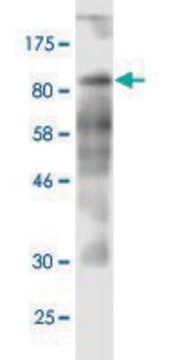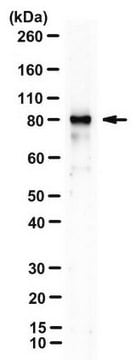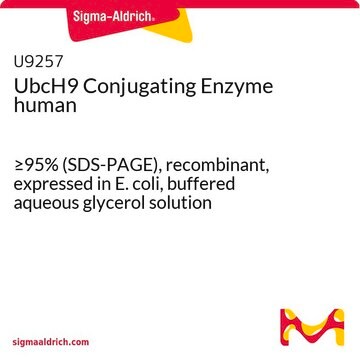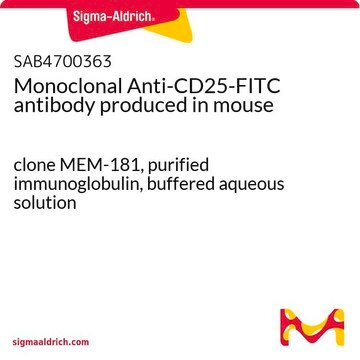MABT1548
Anti-CD97 Antibody, clone CLB‐CD97/1
Synonim(y):
Adhesion G protein-coupled receptor E5, Leukocyte antigen CD97
About This Item
Polecane produkty
pochodzenie biologiczne
mouse
Poziom jakości
forma przeciwciała
purified antibody
rodzaj przeciwciała
primary antibodies
klon
CLB?CD97/1, monoclonal
masa cząsteczkowa
calculated mol wt 92 kDa
observed mol wt ~N/A kDa
oczyszczone przez
using protein G
reaktywność gatunkowa
human
opakowanie
antibody small pack of 100
metody
ELISA: suitable
flow cytometry: suitable
immunofluorescence: suitable
immunohistochemistry: suitable
immunoprecipitation (IP): suitable
inhibition assay: suitable
izotyp
IgG2a
sekwencja epitopowa
N-terminal extracellular domain
numer dostępu Protein ID
numer dostępu UniProt
temp. przechowywania
-10 to -25°C
informacje o genach
human ... ADGRE5(976)
Specyficzność
Immunogen
Zastosowanie
Evaluated by Flow Cytometry in THP-1 cells.
Flow Cytometry Analysis: 1.0 µg of this antibody detected CD97 in one million THP-1 cells.
Tested Applications
Flow Cytometry Analysis: A representative lot detected CD97 in Flow Cytometry applications (Hamann, J., et al. (1996). 184(3):1185-9; Kwakkenbos, M.J., et al. (2002). J Leukoc Biol. 71(5):854-62).
Inhibition Assay: A representative lot of this antibody inhibited erythrocyte adhesion to CD97-transfected COS cells.(Hamann, J., et al. (1996). 184(3):1185-9; Hamann, J., et al. (1998). Eur J Immunol.;28(5):1701-7).
Immunoprecipitation Analysis: A representative lot immunoprecipitated CD97 in Immunoprecipitation applications (Hamann, J., et al. (1996). 184(3):1185-9).
Immunohistochemistry Applications: A representative lot detected CD97 in Immunohistochemistry applications (Hamann, J., et al. (1999). Arthritis Rheum. 42(4):650-8; Steinert, M., et al. (2002). Am J Pathol. 161(5):1657-67).
Immunofluorescence Analysis: A representative lot detected CD97 in Immunofluorescence applications (Hamann, J., et al. (1998). Eur J Immunol. 28(5):1701-7; Hamann, J., et al. (1999). Arthritis Rheum. 42(4):650-8; Steinert, M., et al. (2002). Am J Pathol. 161(5):1657-67).
ELISA Analysis: A representative lot detected CD97 in ELISA applications (Hamann, J., et al. (1999). Arthritis Rheum. 42(4):650-8; Steinert, M., et al. (2002). Am J Pathol. 161(5):1657-67).
Note: Actual optimal working dilutions must be determined by end user as specimens, and experimental conditions may vary with the end user.
Opis wartości docelowych
Postać fizyczna
Rekonstytucja
Przechowywanie i stabilność
Inne uwagi
Oświadczenie o zrzeczeniu się odpowiedzialności
Not finding the right product?
Try our Narzędzie selektora produktów.
Kod klasy składowania
12 - Non Combustible Liquids
Klasa zagrożenia wodnego (WGK)
WGK 2
Temperatura zapłonu (°F)
Not applicable
Temperatura zapłonu (°C)
Not applicable
Certyfikaty analizy (CoA)
Poszukaj Certyfikaty analizy (CoA), wpisując numer partii/serii produktów. Numery serii i partii można znaleźć na etykiecie produktu po słowach „seria” lub „partia”.
Masz już ten produkt?
Dokumenty związane z niedawno zakupionymi produktami zostały zamieszczone w Bibliotece dokumentów.
Nasz zespół naukowców ma doświadczenie we wszystkich obszarach badań, w tym w naukach przyrodniczych, materiałoznawstwie, syntezie chemicznej, chromatografii, analityce i wielu innych dziedzinach.
Skontaktuj się z zespołem ds. pomocy technicznej





